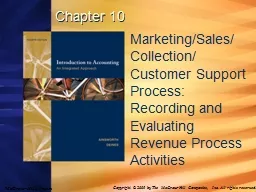

Collection Customer Support Process Recording and Evaluating Revenue Process Activities 10 2 When are Revenues Recognized When earned regardless of when cash is received Assume a December 31 yearend for the following examples ID: 786656
Download The PPT/PDF document "Chapter 10 Marketing/Sales/" is the property of its rightful owner. Permission is granted to download and print the materials on this web site for personal, non-commercial use only, and to display it on your personal computer provided you do not modify the materials and that you retain all copyright notices contained in the materials. By downloading content from our website, you accept the terms of this agreement.
Slide1
Chapter 10
Marketing/Sales/
Collection/
Customer Support Process: Recording and Evaluating Revenue Process Activities
Slide210-
2
When are Revenues Recognized?
When earned, regardless of when cash is received. Assume a December 31 year-end for the following examples.
Example #1—provided services in November and sent a bill to the customer in December, recognize revenue in November
Example #2—received payment in November for services to be provided in December, recognize revenue in December when services are provided to the customer
Example #3—provided services and received payment in November, recognize revenue in November
Slide310-
3
What are the Accounts Used in the Revenue Process?
Sales—gross amount of revenue earned
Sales returns and allowances (contra revenue)—gross amount of allowance given to customer for a return or sales allowance
Sales discount (contra revenue)—discount granted to customers who pay within the discount period
Slide410-
4
Example
Sell $800 of inventory to a customer on account for $1,200 (terms: 2/10, n/30). Customer subsequently returns $200 of inventory for a $300 credit. Customer pays their bill within the discount period. A perpetual inventory system (Chapter 8) is used.
Slide510-
5
Answer
Sale
Increase (debit) accounts receivable by $1,200
Increase (credit) sales by $1,200
Increase (debit) cost of goods sold by $800
Decrease (credit) inventory by $800
Return
Recognize (debit) sales returns & allowances for $300
Decrease (credit) accounts receivable by $300
Increase (debit) inventory by $200
Decrease (credit) cost of goods sold by $200
Slide610-
6
Answer Continued
Payment received within the discount period
Increase (debit) cash by $882 ($900 * 0.98)
Recognize (debit) sales discount for $18 ($900 * 0.02)
Decrease (credit) A/R by $900 ($1,200 - $300)
Slide710-
7
What if Payment is Received After the Discount Period has Expired?
Payment after discount period
Increase (debit) cash by $900
Decrease (credit) A/R by $900 ($1,200 - $300)
Slide810-
8
Thought Questions
Why not simply credit sales for the return?
Management needs a record of returns to evaluate quality and customer service
Why not simply credit sales for the discount or record sales net-of-the discount?
Management needs a record of discounts taken to evaluate credit policies and customer service.
Slide910-
9
What is a Cost Flow Assumption?
A method used to assign a cost to a product when it is not specifically identified with a cost.
FIFO—first-in, first-out
Assumes that the first costs recorded are the first costs expensed
LIFO—last-in, first-out
Assumes that the last costs recorded are the first costs expensed
Slide1010-
10
Example
March 1, beginning inventory 10 units with a cost of $5 each
March 3, purchase 12 units with a cost of $6 each
March 5, sell 15 units
What is the cost of goods sold using FIFO?
(10 * $5) + (5 * $6) = $80
What is the cost of goods sold using LIFO?
(12 * $6) + (3 * $5) = $87
Slide1110-
11
So FIFO is good because it Reduces Costs?
No, for 2 reasons
First, the difference in cost of goods sold between FIFO and LIFO ($7) results in a difference in ending inventory, not a permanent difference in cost. Ending inventory under FIFO is $42 (7 * $6) while ending inventory under LIFO is $35 (7 * $5)
Second, in a period of rising prices (as this example shows) a company using LIFO will incur less tax expense because costs are higher
Slide1210-
12
Why is it Necessary to Estimate Uncollectible Accounts?
Proper matching of revenue and expense—the cost incurred in an attempt to generate revenue is the possibility of not collecting the monies due from customers
Asset definition—accounts receivable should reflect the amount we believe we can collect, amounts which are deemed uncollectible have no future benefit
Slide1310-
13
How are Revenue Process Activities Communicated to Users?
Income statement
Net sales, uncollectible accounts expense, miscellaneous revenues
Balance sheet
Accounts receivable (net), related liabilities (unearned revenue), related assets (inventory)
Statement of cash flows
Cash received from customers
Slide1410-
14
How can we Estimate Cash Received from Customers?
Beginning accounts receivable (balance sheet)
+ Net sales on account (income statement)
= Maximum amount owed by customers
- Cash received from customers (calculated)
- Write-offs (if known)
= Ending accounts receivable (balance sheet)
Slide1510-
15
What are Revenue Variances?
Actual revenues less planned (budgeted) revenues
Sales price variance
(ASP –
BSP
) * AQ
Tells us whether our selling price is greater than or less than expected
Sales quantity variance
(AQ –
BQ
)
*
BSP
Tells us whether we sold more or fewer products than anticipated (budgeted)